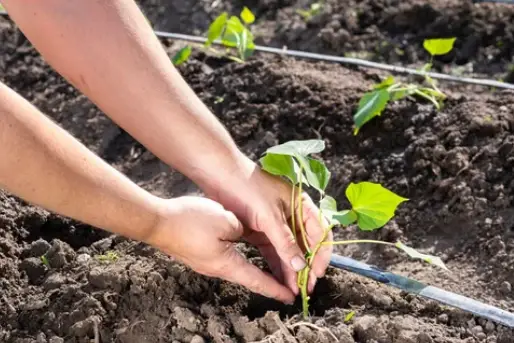Sweet potatoes are a popular root vegetable that is known for its sweet taste and nutritional value.
Many people wonder if sweet potatoes grow underground or above the ground.
The answer is that sweet potatoes grow underground, making them a root vegetable.
Sweet potatoes are a member of the morning glory family, and they are grown from slips, which are small pieces of the sweet potato that are planted in the ground.
The slips will grow into vines that produce sweet potatoes underground.
Sweet potatoes require a warm climate and a long growing season, making them a popular crop in tropical and subtropical regions.
Overall, sweet potatoes are a versatile and nutritious vegetable that can be enjoyed in a variety of dishes.
Knowing that sweet potatoes grow underground can help people better understand how they are grown and harvested.
Growing Sweet Potatoes

Planting Sweet Potatoes
Sweet potatoes are a root vegetable that grows underground, and they are easy to grow in a garden or container. To start, plant sweet potato slips, which are young plants that sprout from the sweet potato. These slips can be purchased at a garden center or grown from a sweet potato at home.
Plant sweet potato slips in the spring after the last frost. Choose a location with full sun and well-draining, sandy soil. Sweet potato vines need room to spread, so plant them about 12 inches apart and 4-6 inches deep.
Caring for Sweet Potato Plants
Sweet potato plants need regular watering and good drainage. Water them deeply once a week, or more often in hot, dry weather. Fertilize them with a nitrogen-rich fertilizer once a month to promote healthy growth.
Sweet potato vines can grow up to 10 feet long, so provide support for them to climb. Use wire cages or trellises to keep them off the ground.
Harvesting Sweet Potatoes
Sweet potatoes are ready to harvest after the vines have died back, which is usually in the fall. Dig up the tubers carefully with a digging fork to avoid damaging them.
After harvesting, cure sweet potatoes by storing them in a warm, humid place for a few weeks. This will help them develop their sweet flavor and improve their storage life.
Sweet potatoes come in a variety of colors, including white, yellow, purple, and even black. They are a nutritious and delicious addition to any meal, and they are easy to grow in a home garden or container.
Sweet Potato Plant

Sweet potato is a perennial plant that is grown for its edible tubers. It is a member of the morning glory family and is known for its sweet and nutritious tubers. The sweet potato plant has vines that grow up to 10 feet long and can be used as a ground cover or trained to grow on a trellis or other support.
Growth and Development
The sweet potato plant grows from a slip, which is a small plant that is grown from a mature sweet potato. The slip is planted in the ground, and the sweet potato plant grows from the slip. The plant requires warm temperatures and plenty of sunlight to grow properly.
The sweet potato plant has large leaves that are heart-shaped and can grow up to 12 inches across. The foliage of the plant is green and provides a lush backdrop for the sweet potato tubers. The plant produces flowers that are small and inconspicuous, and they are not typically harvested for any use.
Characteristics
The sweet potato plant has a unique root system that allows it to store nutrients and water for long periods of time. The tubers of the sweet potato plant are the edible part of the plant and are typically harvested after the foliage has died back.
The sweet potato plant is known for its ability to grow in poor soil conditions and is often used as a cover crop to improve soil quality. The plant is also used in ornamental gardens due to its attractive foliage and vibrant colors.
The botanical name for the sweet potato plant is Ipomoea batatas, and it is a member of the Convolvulaceae family. The plant is a popular crop in many parts of the world and is known for its nutritional value and versatility in cooking.
In conclusion, the sweet potato plant is a versatile and hardy plant that is known for its sweet and nutritious tubers. It requires warm temperatures and plenty of sunlight to grow properly and has a unique root system that allows it to store nutrients and water for long periods of time. The sweet potato plant is a popular crop in many parts of the world and is used for both food and ornamental purposes.
Soil and Water Requirements
Soil Type and pH
Sweet potatoes require well-drained soil with a pH level between 5.0 and 6.5. Sandy soil is ideal for sweet potatoes as it allows for good drainage and prevents the soil from becoming waterlogged. The soil should also be rich in organic matter to provide the necessary nutrients for the sweet potato plant to grow.
Watering Needs
Sweet potatoes require a consistent supply of water throughout the growing season. The soil should be kept moist but not waterlogged, as this can lead to root rot. It is important to water the sweet potato plant deeply and regularly, especially during hot and dry weather conditions.
To ensure proper drainage and moisture retention, black plastic can be used to cover the soil around the sweet potato plant. This will help to maintain a consistent temperature and humidity level in the soil, which is important for the growth and development of the sweet potato plant.
Fertilizer can also be used to provide additional nutrients, particularly nitrogen, which is essential for the growth of the sweet potato plant. However, it is important not to over-fertilize, as this can lead to excessive foliage growth at the expense of root development.
In summary, sweet potatoes require well-drained sandy soil with a pH level between 5.0 and 6.5, consistent watering, and a supply of nutrients such as nitrogen. Proper soil and water management is essential for the growth and development of the sweet potato plant.
Light and Temperature Requirements
Sunlight
Sweet potatoes require ample sunlight to grow properly. They thrive in full sun, which means at least six hours of direct sunlight per day. However, they can also tolerate some shade, especially during the hottest parts of the day. If you’re planting sweet potatoes in a garden, choose a spot that gets plenty of sun and is protected from strong winds.
Temperature
Sweet potatoes prefer warm temperatures and can be damaged by frost. They grow best in soil that is between 60 and 85 degrees Fahrenheit. In fact, they won’t even start to grow until the soil temperature reaches at least 60 degrees. If you live in a colder climate, you may need to start your sweet potatoes indoors or wait until after the last spring frost to plant them outside.
During the growing season, sweet potatoes need consistent temperatures. Fluctuations in temperature can cause the tubers to crack or become misshapen. Once the sweet potatoes are harvested, they should be stored in a warm, dry place. Temperatures below 50 degrees can cause the tubers to decay, while temperatures above 60 degrees can cause them to sprout prematurely.
In conclusion, sweet potatoes require plenty of sunlight and warm temperatures to grow properly. If you provide them with these conditions, they will reward you with a bountiful harvest.
Pests and Diseases
Common Pests
Sweet potatoes are susceptible to a number of pests, including wireworms, sweet potato weevils, and whiteflies. Wireworms are the larvae of click beetles and can cause significant damage to sweet potato roots. Sweet potato weevils are small insects that lay their eggs on the vines, and their larvae can bore into the sweet potatoes, causing significant damage. Whiteflies are small, winged insects that feed on the leaves of sweet potato plants and can cause significant damage to the foliage.
To prevent infestations of these pests, it is important to practice good crop rotation, avoid planting sweet potatoes near other crops that are susceptible to the same pests, and use insecticides as necessary.
Common Diseases
Sweet potatoes are also susceptible to a number of diseases, including black rot, fusarium wilt, and southern blight. Black rot is caused by a fungus that can infect the roots and cause them to rot. Fusarium wilt is caused by a soil-borne fungus that can cause wilting, yellowing, and stunted growth. Southern blight is caused by a soil-borne fungus that can cause wilting, yellowing, and death of the plant.
To prevent the spread of these diseases, it is important to practice good sanitation, remove infected plants and plant debris, and use fungicides as necessary.
Wireworms
Wireworms are a common pest of sweet potatoes and can cause significant damage to the roots. They are the larvae of click beetles and can be difficult to control. To prevent infestations of wireworms, it is important to practice good crop rotation, avoid planting sweet potatoes near other crops that are susceptible to wireworms, and use insecticides as necessary.
Diseases
Sweet potatoes are susceptible to a number of diseases, including black rot, fusarium wilt, and southern blight. These diseases can be difficult to control once they have infected the plants. To prevent the spread of these diseases, it is important to practice good sanitation, remove infected plants and plant debris, and use fungicides as necessary.




